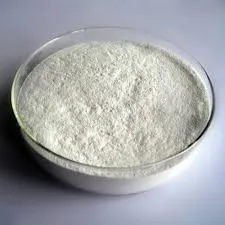
Dec . 04, 2024 16:58 Back to list
redispersible polymer
Understanding Redispersible Polymers Their Importance and Applications
Redispersible polymers (RDPs) are finely powdered polymer additives that can be easily redispersed in water to form stable emulsions or dispersions. These polymers play a vital role in a variety of industries, including construction, coatings, adhesives, and more. They are created through a drying process, where a polymer dispersion is dried to form a free-flowing powder. This paper aims to explore the properties, applications, and benefits of redispersible polymers.
What are Redispersible Polymers?
Redispersible polymers are typically produced from various types of polymeric materials, including vinyl acetate, ethylene, acrylate copolymers, and styrene butadiene rubber. The main characteristic of RDPs is their ability to be redispersed in water after being in a dry state. When mixed with water, they quickly hydrate to form a film or dispersion, which can enhance the performance of the final product.
Properties of Redispersible Polymers
The key properties of redispersible polymers include
1. Adhesion RDPs improve the adhesion of construction materials to various substrates, enabling stronger and more durable bonds.
2. Flexibility Once redispersed, these polymers provide flexibility to the formulations, which is essential in applications that undergo thermal and mechanical stress.
3. Water Resistance RDPs enhance the water resistance of construction materials, making them suitable for use in humid environments.
5. Durability The integration of RDPs contributes to the long-lasting characteristics of products like tile adhesives, plasters, and mortars.
Applications of Redispersible Polymers
1. Construction Industry
In the construction sector, RDPs are widely used in tile adhesives, repair mortars, and facade coatings. They help to strengthen the bonding of tiles to various surfaces, ensuring long-lasting results. Additionally, RDPs enhance the flexibility of mortars, allowing them to withstand cracks and movements in structures. Their water resistance properties are particularly advantageous in outdoor applications, safeguarding against moisture ingress.
redispersible polymer

2. Coatings
Redispersible polymers are essential in the paint and coatings industry. They are incorporated into formulations to improve adhesion, durability, and resistance to environmental factors such as water and UV radiation. These properties are crucial for achieving high-quality finishes on surfaces.
3. Adhesives
RDPs are often used as key components in adhesives. Their ability to redispersed provides excellent bonding capabilities and enhances the performance of adhesive formulations, making them suitable for both household and industrial applications.
4. Sealants
In sealant applications, RDPs improve elasticity and adhesion, which are critical for ensuring a tight seal that can accommodate movement without cracking.
Benefits of Using Redispersible Polymers
The incorporation of RDPs into formulations offers several benefits
- Enhanced Performance RDPs improve the overall performance characteristics of products, leading to better adhesion, flexibility, and durability.
- Cost-Effectiveness By using RDPs, manufacturers can create high-quality products that meet performance requirements without compromising cost.
- Environmentally Friendly Many RDPs are produced from renewable resources and are designed to be low in volatile organic compounds (VOCs), making them a more environmentally friendly option for construction and coating applications.
- Versatility RDPs can be used across a wide range of applications, making them a versatile choice for formulators looking to improve their products.
Conclusion
Redispersible polymers are essential components in various industries, particularly in construction and coatings. Their unique ability to be redispersed into water and improve the performance characteristics of materials makes them invaluable in creating high-quality products. With benefits such as enhanced adhesion, flexibility, and durability, RDPs contribute significantly to the longevity and functionality of construction materials and coatings. As industries continue to innovate, the use of redispersible polymers is expected to grow, driving advancements in material science and application technologies. Their importance in modern manufacturing cannot be overstated, as they aid in creating products that meet increasingly demanding performance standards while remaining environmentally responsible.
-
Versatile Hpmc Uses in Different Industries
NewsJun.19,2025
-
Redispersible Powder's Role in Enhancing Durability of Construction Products
NewsJun.19,2025
-
Hydroxyethyl Cellulose Applications Driving Green Industrial Processes
NewsJun.19,2025
-
Exploring Different Redispersible Polymer Powder
NewsJun.19,2025
-
Choosing the Right Mortar Bonding Agent
NewsJun.19,2025
-
Applications and Significance of China Hpmc in Modern Industries
NewsJun.19,2025







